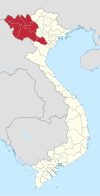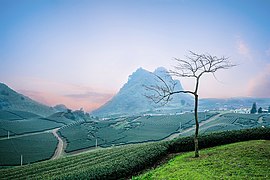| Mộc Châu Town Thị xã Mộc Châu | |
|---|---|
| District-level town (Class-4) | |
 View from the Mộc-châu Plateau to the Hòa Bình Dam. View from the Mộc-châu Plateau to the Hòa Bình Dam. | |
| Nickname: The White Meadowland | |
| Motto(s): "Thảo nguyên tràn nhựa sống" (The meadowland of the white milk) | |
| Coordinates: 20°55′19″N 104°45′08″E / 20.9220823°N 104.7520939°E / 20.9220823; 104.7520939 | |
| Country | |
| Region | Northwest |
| Province | Sơn La |
| Central agency | Little Zone 4, Mộc Châu town |
| Government | |
| • Type | Town People's Committee |
| • President | Lê Trọng Bình |
| • Vice-President | Lê Hồng Minh |
| Area | |
| • Total | 1,072.09 km (413.94 sq mi) |
| Population | |
| • Total | 148,259 |
| • Density | 140/km (360/sq mi) |
| Time zone | UTC+7 (Indochina Time) |
| ZIP code | 34700 |
| Website | Mocchau.Sonla.gov.vn Mocchau.Sonla.dcs.vn |
Mộc Châu is a town of Sơn La province in the Northwest region of Vietnam.
History
Middle Ages
Its name Mộc-châu in Kinh language is originated from Muaeng Mol (Mường Mỗi, "the land of barbarians") in the Black Tai language. This word is used to refer to the Xá ethnic groups, who are the ancient owners of the land. After being expelled from Mộc Châu, they transformed into Muong people.
During the Lý-Trần dynasties, the land where Mộc Châu is now the Southern part of Đà Giang province (Đà-giang đạo) of the Annamese Empire, although it was still completely independent in reality. A leader was well known in Annamese history called Trịnh Giốc Mật.
Previously, the strip of land from Mộc Châu to Mai Châu was once considered one and had no official name. Until the end of the Early Lê dynasty, or the 17th century, this area was divided into three parts : Mộc Châu belonged to Black Tai leaders (Taydam), and Mai Châu for the White Tai ones (Taykhao), in addition to a few of villages in the southernmost became the part of Xam Neua (Muang Phuan kingdom). The situation like this was almost kept until the Nguyễn dynasty completely weakened by the pressure of the French colonialists.
XX century
During the French colonial period, Mộc Châu's leadership clans were recognized by the French government in Indochina with limited autonomy within the Tai Federation. They were allowed to have their own flags and guards. Currently, the Sơn La Provincial Museum still stores some black flags with embroidered white snakes, which are symbols of the land.
In the 1952 Nasan campaign ("cassava field" in Tai language), Mộc Châu was used by Vietminh forces as a military supply center to quickly cut off the "stomach" of the French armies (CEFEO) in the Northwest region.
XXI century
On November 14, 2025, the National Assembly Standing Committee of Vietnam issued the Resolution No.1280/NQ-UBTVQH15 on the arrangement of district and commune administrative units in Sơn La province in the period of 2023-2025. Accordingly, officially establishing Mộc-châu Town on the basis of the entire natural area is 1,072.09 km2 and the population size is 148,259 people of old Mộc-châu District. Regarding affiliated administrative units, Mộc-châu Town has 15 administrative units at commune level, including 8 wards and 7 communes. On November 25, Sơn La Provincial People's Committee held a press conference and reached agreement that it would hold the Ceremony to announce the establishment of Mộc-châu Town on January 18, 2025.
Culture
The name of Mộc-châu (Muaeng-mol) has been mentioned in the famous epics Táy pú xớc and Quắm tố mướng of White Tai people about 17th century.
According to an old legend, Mộc Châu is the venue that used to take place a horse race to divide the border between the Black Tai people and the Xá ethnic groups. The Tai men used a newly born horse to participate in the competition, and as a result, they won to chase the Xá people to step back to Hòa Bình province. Currently, grass horse racing is an annual festival held on every Lunar New Year.
Mộc Châu is popular with Vietnamese and international tourists for its hill tribes such as White & Black Thai People and Muong People, the green tea hills, Mộc Châu milk, the natural landscape of Dải Yếm waterfalls, Hill Pine and Orchid Garden flowers.
This town takes five hours driving, with a distance of 200 kilometres (120 mi) from Hanoi to Mộc Châu.
Geography
Mộc Châu town (Thị-xã Mộc-châu) is 200 kilometers from the capital of Hanoi. As of 2019 it had a population of 114,460. The town covers an area of 1,081.66 km, ranking 8th among 12 city districts of Son La Province.
Moc Chau belongs to the highland landscape class in the horizontal classification system of Vietnamese landscape, with characteristics of climate, ecology and human life.
Moc Chau is distributed on the terrain with an average elevation of more than 1,050 m above the sea level. The annual average temperature of Moc Chau is 18.7 °C, it has cool climate due to lying between the Da River (northeast) and Ma River (southwest). These two river systems act as two natural air conditioning systems. At the same time, Moc Chau has a high climate division along the belt, so it has both the characteristics of the subtropical and temperate highland climate, which is very convenient for developing tourism for the whole year.
Climate
| Climate data for Mộc Châu, elevation 958 m (3,143 ft) | |||||||||||||
|---|---|---|---|---|---|---|---|---|---|---|---|---|---|
| Month | Jan | Feb | Mar | Apr | May | Jun | Jul | Aug | Sep | Oct | Nov | Dec | Year |
| Record high °C (°F) | 29.0 (84.2) |
31.4 (88.5) |
33.5 (92.3) |
34.2 (93.6) |
36.3 (97.3) |
33.3 (91.9) |
33.5 (92.3) |
34.5 (94.1) |
31.7 (89.1) |
31.1 (88.0) |
29.5 (85.1) |
29.2 (84.6) |
36.3 (97.3) |
| Mean daily maximum °C (°F) | 17.2 (63.0) |
19.0 (66.2) |
22.8 (73.0) |
26.3 (79.3) |
27.7 (81.9) |
27.7 (81.9) |
27.6 (81.7) |
27.0 (80.6) |
25.8 (78.4) |
23.5 (74.3) |
20.8 (69.4) |
18.0 (64.4) |
23.6 (74.5) |
| Daily mean °C (°F) | 12.3 (54.1) |
13.8 (56.8) |
17.2 (63.0) |
20.6 (69.1) |
22.6 (72.7) |
23.3 (73.9) |
23.2 (73.8) |
22.7 (72.9) |
21.5 (70.7) |
19.2 (66.6) |
16.2 (61.2) |
13.1 (55.6) |
18.8 (65.8) |
| Mean daily minimum °C (°F) | 9.4 (48.9) |
10.8 (51.4) |
13.8 (56.8) |
17.0 (62.6) |
19.4 (66.9) |
20.6 (69.1) |
20.6 (69.1) |
20.1 (68.2) |
18.8 (65.8) |
16.4 (61.5) |
13.2 (55.8) |
10.0 (50.0) |
15.8 (60.4) |
| Record low °C (°F) | −0.9 (30.4) |
0.4 (32.7) |
2.2 (36.0) |
7.3 (45.1) |
11.4 (52.5) |
13.8 (56.8) |
15.2 (59.4) |
15.8 (60.4) |
11.7 (53.1) |
8.3 (46.9) |
3.3 (37.9) |
−1.5 (29.3) |
−1.5 (29.3) |
| Average precipitation mm (inches) | 21.9 (0.86) |
21.3 (0.84) |
49.9 (1.96) |
101.9 (4.01) |
182.6 (7.19) |
231.3 (9.11) |
268.0 (10.55) |
318.6 (12.54) |
257.2 (10.13) |
132.3 (5.21) |
38.0 (1.50) |
18.0 (0.71) |
1,640.4 (64.58) |
| Average rainy days | 10.9 | 10.9 | 12.5 | 14.9 | 17.9 | 18.3 | 21.0 | 21.1 | 16.3 | 13.3 | 10.1 | 7.9 | 175.5 |
| Average relative humidity (%) | 87.4 | 86.9 | 84.0 | 82.9 | 82.3 | 84.6 | 86.3 | 88.1 | 87.8 | 86.4 | 85.8 | 85.2 | 85.6 |
| Mean monthly sunshine hours | 134.4 | 128.2 | 151.3 | 170.6 | 191.0 | 155.5 | 162.3 | 154.9 | 157.1 | 150.4 | 149.0 | 152.6 | 1,851.1 |
| Source: Vietnam Institute for Building Science and Technology | |||||||||||||
Landspaces
See also
Notes and references
- ^ Nghị quyết số 72/NQ-CP của Chính phủ về việc điều chỉnh địa giới hành chính huyện Mộc Châu để thành lập huyện Vân Hồ thuộc tỉnh Sơn La.
- ^ General Statistics Office of Vietnam (2019). "Completed Results of the 2019 Viet Nam Population and Housing Census" (PDF). Statistical Publishing House (Vietnam). ISBN 978-604-75-1532-5.
- Công-bố quyết-định thành-lập thị-xã Mộc-châu
- "Districts of Vietnam". Statoids. Retrieved March 13, 2009.
- "Vietnam Institute for Building Science and Technology" (PDF). Retrieved 16 August 2023.
Further reading
Bibliography
- George Coedes. The Making of South East Asia, 2nd ed. University of California Press, 1983.
- Trần Ngọc Thêm. Cơ sở văn hóa Việt Nam (The Foundation of Vietnamese Culture), 504 pages. Publishing by Nhà xuất bản Đại học Tổng hợp TPHCM. Saigon, Vietnam, 1995.
- Li Tana (2011). Jiaozhi (Giao Chỉ) in the Han period Tongking Gulf. In Cooke, Nola ; Li Tana ; Anderson, James A. (eds.). The Tongking Gulf Through History. University of Pennsylvania Press. pp. 39–44. ISBN 9780812205022.
- Li Tana, Towards an environmental history of the eastern Red River Delta, Vietnam, c.900–1400, Journal of Southeast Asian Studies, 2014.
- Samuel Baron, Christoforo Borri, Olga Dror, Keith W. Taylor (2018). Views of Seventeenth-Century Vietnam : Christoforo Borri on Cochinchina and Samuel Baron on Tonkin. Cornell University Press. ISBN 978-1-501-72090-1.
External links
| Districts of Northwest Vietnam | ||
|---|---|---|
| Điện Biên province |  | |
| Hòa Bình province | ||
| Lai Châu province | ||
| Lào Cai province | ||
| Sơn La province | ||
| Yên Bái province | ||
| denotes provincial seat. | ||


